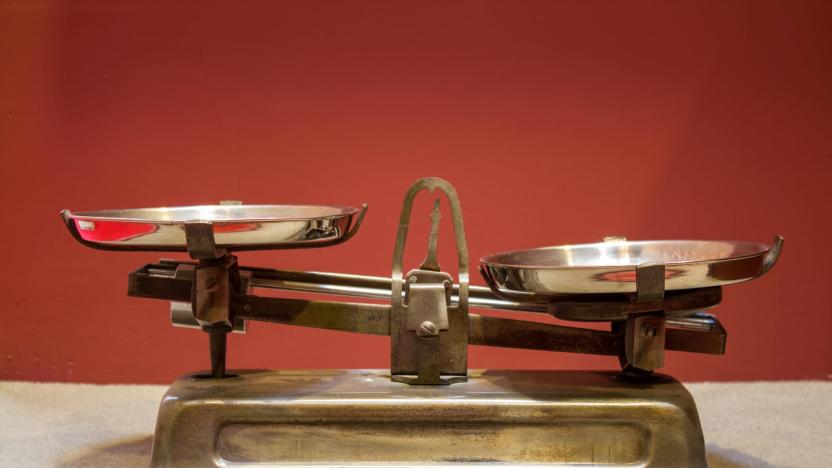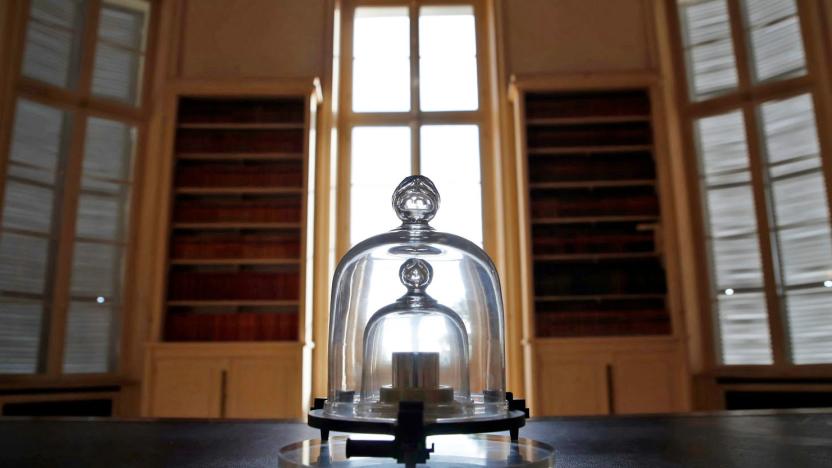kilogram
Latest

On May 20th, the kilogram will no longer be defined by a lump in France
On May 20th, World Metrology Day, the scientific community will officially change the definition of the kilogram. For 130 years, the kilo has been defined by a physical cylinder of platinum-iridium alloy, known as Le Grand K and stored in a vault outside of Paris. But every time scientists handled it, the cylinder lost atoms -- an estimated 50 micrograms over its lifetime. So, beginning Monday, the kilogram will officially be measured by a physical constant known as the Planck constant.

The kilogram has officially been redefined
Today, scientists voted to change the definition of the kilogram as well as three other units of measurement -- the ampere, the kelvin and the mole. The vote took place at the General Conference on Weights and Measures in Versailles, France and the new definitions will be based on "what we call the fundamental constants of nature," as Estefanía de Mirandés of the International Bureau of Weights and Measures (BIPM) told Science News, instead of the less precise definitions these measurements are currently tied to. The kilogram, for example, is defined by a physical cylinder known as Le Grand K that's stored in a vault outside of Paris.

Why scientists are redefining the kilogram
Physics is a funny thing. Despite dictating the behaviors and states of everything from atoms to stars, our interpretation of its effects are rooted in very human constructs. Meters, amperes and seconds were all defined using arbitrary terms and methods. For years, the kilogram and meter weren't just terms, they were physical objects held in a Paris vault that some Victorian-era committee just decided would be the standard. But now, for the first time since the international system of units (SI) was launched in 1960, the International Bureau of Weights and Measures (BIPM) is redefining four basic units of measurement, not by any human metric but by the immutable forces of the universe. "This is the most important decision that the BIPM has made in maybe 100 years, which may be a slight exaggeration, but at least since 1960 when they adopted the international system of units," Dr. Terry Quinn, emeritus director of the BIPM, said. A committee from the BIPM met in Paris this week and voted on Friday to recommend redefining the kilogram, mole, ampere and Kelvin. The motion will be put up for a vote at the General Conference on Weights and Measures (CGPM) next November. "For the scale that's in your grocery store or bathroom, nothing's going to change," Dr. David Newell of the National Institute of Standards and Technology (NIST) said. Instead, as Dr. Quinn explains, "it will give you the ability to make accurate measurements on scales far different from the current scale."

The way scientific units are calculated is changing
Scientific units are set to receive their biggest shake-up since the inception of the modern metric system in 1960. The International Bureau of Weights and Measures (BIPM) -- one of three committees that oversees this type of stuff -- is presently looking into revising the ampere, the kilogram, the kelvin, and the mole. The higher-ups at the General Conference on Weights and Measures will then conduct a final vote on the recommendations next year, before ordering them into effect in May 2019. Although it may not impact everyday measurements, the redefinition is crucial for scientists, who require the utmost accuracy for their work.

Researchers help give the kilogram a fundamental equivalent
Much to the consternation of scientists, the cylindrical platinum-iridium artifacts that represent the kilogram (see image above) have been gradually packing on extra weight due to surface contamination. Since that unit of measure is the last to be based on an artifact and not a physical constant of nature -- for instance, a meter is the distance light travels in a vacuum during 1/299,792,458 of a second -- it means that scientists no longer know exactly how much a kilogram is. That makes experiments requiring extreme precision more difficult, so researchers from Mettler Toledo, CERN and the EPFL have been working for the last 15 years on a so-called Watt balance, which works on the principle of electromagnetic force restoration. The team managed to created a "load cell" that's accurate to a 0.3 µg resolution for a 2kg weight, well below the desired level of 1 µg -- meaning the goal of replacing a hunk of metal from 1878 with something more, ahem, solid is within reach by the 2015 target date.

Physicist fight: how heavy is a kilogram?
Physicists are currently hotly debating a topic some of us never think about -- or if we did -- surely we'd think 'there's an answer for that, even if I don't know what it is.' The question? The question at hand is 'how heavy is a kilogram?' The currently accepted answer is the mass of a cylinder of platinum and iridium called the International Prototype Kilogram. The problem with that definition, of course, is that not just anybody can measure it -- since most of us don't have an International Prototype Kilogram laying around, especially since every time the thing is picked up a few atoms rub off of it making it a little bit lighter. Because of this, the actual International Prototype Kilogram (yes, there does only seem to be one in existence) is stored in a vault in Sevres, France, limiting the lay person's ability to determine the actual weight of a kilogram. There are other options on the table, of course, including one involving a two-stories high piece of equipment that costs around $1.5 million -- which isn't much better, when you think of it. Enter Ronald Fox and friends over at the National Institute of Standards and Technology. They're suggesting a rather shocking solution: make the kilogram equal to the mass of a certain number of carbon-12 atoms (2250× 28148963^3 of them), also known as a cube of carbon measuring 8.11 centimeters on each side. This would mean, of course, that pretty much anybody could determine the weight of a kilogram at home. But we wouldn't want that, now, would we?

Scientists create roundest objects in the world
Okay, so we could pretty much figure out that JVC's breath sphere speaker wasn't exactly the roundest thing we'd ever seen, but we can't say we've really ever given much thought to how round / not round a round object really is. Thankfully, the scientists involved in the Avogadro Project do give it some thought, and they're toiling away as we speak in an attempt to create almost useless silicon balls which serve one simple purpose: to "redefine the kilogram in terms of magnetic fields and electrical forces." What does weight have to do with this? Currently, the kilogram is the "only remaining standard of measurement tied to a single physical object: a 120-year-old lump of platinum and iridium that sits in a vault outside of Paris, France." Trivial? A bit -- but don't tell that to the guys that weigh gold bars.





